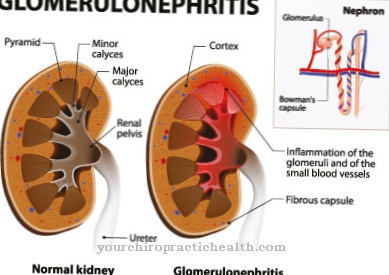The West Syndrome is a difficult to treat generalized malignant form of epilepsy. It occurs in babies between the ages of three and twelve months.
What is West Syndrome?
The West Syndrome was named after the English doctor and surgeon William James West. He observed the first epilepsy attacks of this kind in his four-month-old son in 1841 and then described the disease from a scientific point of view. As a synonym for the term West Syndrome are also the expressions infant malignant epilepsy or BNS epilepsy as an abbreviation for Blitz Nick Salaam Epilepsy used.
Infant malignant epilepsy is believed to be based on organic brain damage that occurred before, during, or after birth. Generalized epileptic seizures are characteristic of West syndrome. The disease affects 1 in 4,000 to 6,000 children. Boys are more often affected than girls.
In 90 percent of the sick children, the seizures first occur within the first twelve months after birth. The peak of manifestation is in the fifth month. In rare cases, the seizures do not occur until the age of two or four. One in 20 cases of epilepsy in early childhood is due to West syndrome.
causes
The exact biochemical mechanisms of the origin of the West Syndrome are still unclear. The seizures are probably caused by a neurotransmitter disorder. The cause is probably a regulatory disorder of the GABA metabolism. An overproduction of the corticotropin releasing hormone in the pituitary gland may also be to blame. A multifactorial interaction in the development of the disease is also conceivable.
Since the West syndrome only occurs in infants and young children, the state of maturity of the brain seems to play a role in the development of the seizures. In the immature newborn brains, not all nerve fibers are yet myelinated. The brain may therefore react to stress or damage with West syndrome. An organic brain disorder can be detected in two thirds of the children.
Developmental disorders of the cerebral cortex, microcephaly, lissencephaly or malformations of blood vessels can be found. Aicardi syndrome, general degenerative brain diseases, phacomatoses such as tuberous sclerosis or brain atrophy can also lead to West syndrome.
West syndrome can also develop after encephalitis or bacterial meningitis. Further risk factors are congenital infections, neurometabolic diseases or hypoglycaemia.In the specialist literature, brain damage from cerebral haemorrhage, stroke, traumatic brain injury or hypoxia during childbirth are also named as causes.
There are cases of illness that appear for the first time as a conceivable side effect after multiple vaccinations against measles, rubella and mumps. However, the West syndrome has not yet been recognized as a vaccine damage. If a cause can be proven, it is symptomatic West syndrome. If West Syndrome cannot be detected, it is assumed to be cryptogenic West Syndrome. No cause can be identified in 20 percent of all children with West Syndrome.
Symptoms, ailments & signs
The epileptic seizures that occur in children with West Syndrome can be divided into three different forms. The lightning attacks are expressed by lightning-like twitching of individual body parts or the entire body. The legs are suddenly bent and the children show violent myoclonic jerks.
The neck and throat muscles twitch during the nodding attacks. The chin is bent towards the chest in a flash. The head may also be drawn in. These movements are reminiscent of a nod of the head, which is why the seizures are referred to as nodding fits.
Salaam fits are rapid forward bending of the head and upper body. At the same time, the children throw their bent arms up and / or bring their hands together in front of their chests. Because this type of seizure is reminiscent of the Salaam greeting, the seizures were called Salaam seizures.
No connection can be found between the seizures and external stimuli. The seizures often occur shortly before you fall asleep or right after you wake up. Classically, the cramps start weak and then increase later in clusters of up to 150 attacks, with less than 60 seconds elapsing between the individual attacks.
The individual cramps can vary in length and intensity depending on the child. There is no pain associated with them and the children usually remain fully conscious. However, the seizures are very exhausting, so that the children can be very tearful after a series of seizures.
Diagnosis & course of disease
Even before the diagnosis is made, the affected children stand out due to delayed psychomotor development. An EEG is performed to confirm the diagnosis. Here the epileptic activity shows itself in the form of irregularly high and slow delta waves. Spikes and sharp waves are built into these delta waves.
In addition to measuring the electrical activity, blood and urine are examined in the laboratory for chromosome peculiarities, hereditary diseases, infectious diseases and metabolic diseases. Imaging methods such as ultrasound, positron emission tomography, magnetic resonance tomography or computer tomography can be used to check peculiarities of the brain.
Complications
In the worst case scenario, West Syndrome can lead to death. However, this only occurs if the condition is not treated. Those affected suffer from epileptic seizures at a very young age. These represent a mortal danger to the child and must therefore be treated by a doctor immediately.
Furthermore, most children suffer from twitching, so that bullying or teasing can occur, especially at a young age. This often leads to psychological complaints or depression. Likewise, the patients often suffer from restricted mobility or from concentration disorders, so that child development is also significantly restricted by the West syndrome.
In adulthood, those affected therefore also suffer from severe restrictions and disorders. The epileptic seizures are also often associated with severe pain. In many cases, the parents or relatives also suffer from severe psychological complaints or from depression.
Treatment of West syndrome can be carried out with the help of surgical interventions. Compilations do not occur. However, it is not possible to predict whether the epileptic seizures will be completely reduced. In many cases, this significantly reduces the life expectancy of the person affected.
When should you go to the doctor?
The general state of health of newborns and infants should always be checked and monitored regularly. Especially in the first weeks or months of life, the child's developments should be observed and documented as best as possible. Any abnormalities and changes must be discussed with the pediatrician so that it can be clarified whether there is a need for action or whether everything corresponds to a natural development.
In the event of a seizure or an involuntary twitching of the offspring, there is an acute need for action. Medical examinations must be initiated to clarify the cause. If the child's movements are irregular or do not correspond to the natural conditions, it is advisable to consult a doctor. Weeping behavior, refusal to eat or disturbances in the digestive tract are warning signals of the organism.
A doctor should be consulted so that the observations can be better assessed. In the event of a disturbance of consciousness or a loss of consciousness, an ambulance service should be alerted. It is an acute situation in which the child must be reacted to as quickly as possible and intensive medical care is required. Until the emergency doctor arrives, the instructions of the rescue service must be followed in order to save the life of the baby. A doctor should also be consulted in the event of a child who screams for a long time, changes in skin texture or the assumption that the offspring may be in pain.
Therapy & Treatment
West syndrome is very difficult to treat. An early diagnosis increases the probability that little or no consequential damage will remain. If the disease is based on a treatable organic brain feature, surgical correction can be made.
Epilepsy surgery can get rid of the causes of the seizures. In most cases, however, West syndrome is treated with medication. The children receive ACTH, oral corticosteroids, or vigabatrin. Sultiam or pyridoxine are also administered. However, most anticonvulsant drugs have been found to be ineffective in West syndrome.
prevention
The exact pathogenesis of West Syndrome is still unclear, so that the disease cannot currently be prevented.
Aftercare
West syndrome is a severe form of epilepsy that can be treated with drugs or surgery, for example. The administration of drugs such as valproate or zonisamide must be strictly controlled. Children in particular are sensitive to the active ingredients, which is why close monitoring by the doctor is strongly recommended.
Repeated medication changes are common when treating the condition. The dose must be adjusted regularly or the preparation must be changed. If a ketogenic diet is part of the therapy, the progress must be discussed with a specialist or nutritionist at regular intervals. More visits to the doctor are usually required after epilepsy surgery, as it is a risky procedure that can have side effects.
The frequency of medical check-ups depends on the type and severity of the epilepsy and the course of the procedure. Parents of affected children contact the responsible pediatrician and discuss the details with them. Follow-up care is provided by the pediatrician or neurologist who is already taking over the therapy. Epilepsy can usually not be cured permanently. Therefore, follow-up care is an ongoing process designed to cure individual symptoms and monitor medication.
You can do that yourself
Children who suffer from West Syndrome need support in everyday life, as the recurring epileptic seizures can be a great burden. Measures must be taken to avoid falls and accidents during an epileptic seizure. In addition, treatment options such as epilepsy surgery or drug treatment using vigabatrin or oral corticosteroids must be exhausted. Parents of affected children should contact a suitable specialist center at an early stage, as the chances of recovery decrease as the child gets older.
In addition, general measures apply to improve the child's well-being. Physical exercise and mental support are important, but also an adapted diet and specially tailored therapies. For example, a ketogenic diet has been shown to be effective in epilepsy. The Association for Nutrition in Epilepsy FET e. V. gives those affected further recommendations regarding the diet.
Children who suffer from West Syndrome must be informed about their condition at an early stage. Discussions with doctors and other affected persons are ideal for this, but also information material such as books or brochures. Together with the doctor responsible, further strategies for dealing with the disease on a daily basis can be developed.

.jpg)

























